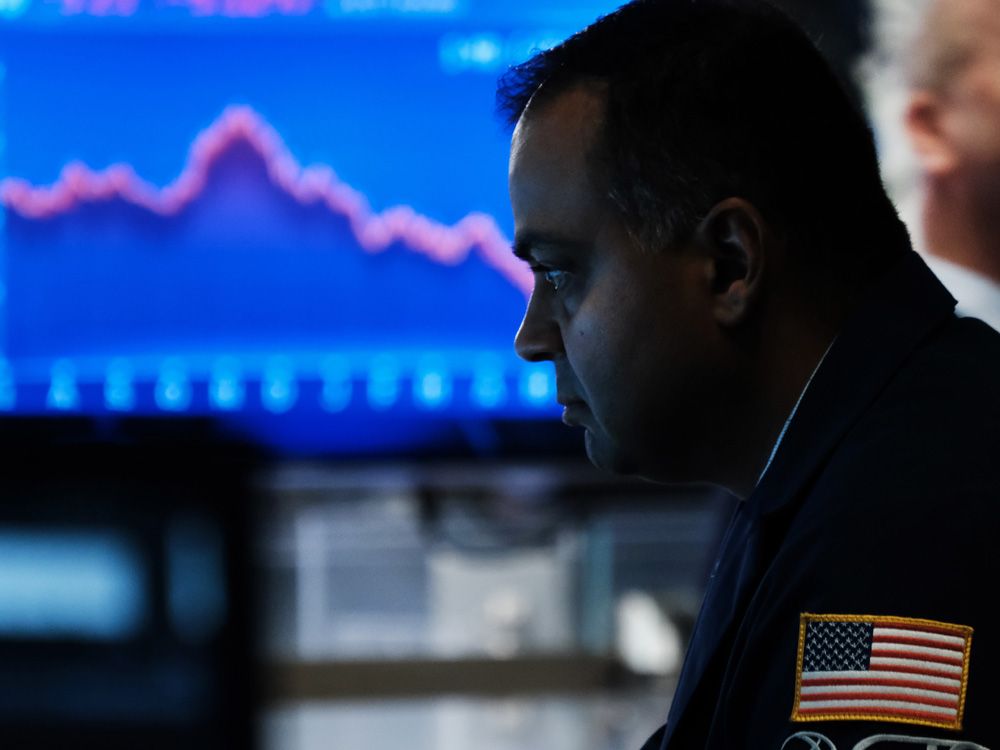The only questions are how deep and how long
Traders work on the floor of the New York Stock Exchange. Photo by Spencer Platt/Getty Images files By David Rosenberg and Brendan Livingstone
Advertisement 2 This advertisement has not loaded yet, but your article continues below.
The stock market, which led the economy out of the COVID-19-induced recession, is once again serving as a leading indicator of economic activity. Indeed, the 24 per cent peak-to-trough decline (so far) in the S&P 500 — in just over five-months’ time — is a historically rare event, and in the past has been a very reliable harbinger of recession.
In fact, since 1970, a 20-per-cent-plus draw down in the S&P 500 over a five-plus month time span has resulted in a recession 100 per cent of the time (five for five). You can either play the odds or hope this time will be different.
However, from our standpoint, the fact that the Fed is remaining ultra-aggressive — heading into a growth slowdown — would suggest a recessionary outcome should be the base case (as the stock market is suggesting). In our view, the unresolved issues are: i) the magnitude of the decline in economic activity; and ii) the duration of said decline.
Advertisement 3 This advertisement has not loaded yet, but your article continues below.
To get a better sense of what the stock market is signalling — in terms of the extent of the recessionary outcome — we matched various segments of the S&P 500 to different economic categories. We ultimately landed on the following:
Real personal consumption expenditures: average of the S&P 500 retailing industry, S&P 500 consumer services industry, S&P 500 consumer durables & apparel industry, and S&P 500 media & entertainment industry.
Real manufacturing shipments (capex): average of the S&P 500 tech sector and S&P 500 capital goods industry.
Housing starts (single-family): the S&P 500 home building industry.
In each case, we looked at the year-over-year per cent change in the S&P 500 segments (deflated by CPI) against the corresponding economic indicator. Our results suggest that the stock market leads the economy between one to eight months depending on the variable in question. As an example, housing, which is often thought of as the preeminent leading indicator for the economy, only lags its corresponding stock market category (home building stocks) by one month. Conversely, consumer spending, which is more a coincident indicator of economic activity, lags its stock market comparable by eight months.
Advertisement 4 This advertisement has not loaded yet, but your article continues below.
More On This Topic David Rosenberg: Four reasons corporate bonds have become more appealing than equities David Rosenberg: Identifying opportunities for income investors by screening for dividend yield David Rosenberg: Why the market hasn’t bottomed With this in mind, the damage that has occurred in the stock market, thus far, already points to a pretty meaningful decline in economic activity in the coming months/quarters. For example, the draw down in home building stocks suggests that single-family housing starts will decline about 8 per cent to 10 per cent relative to year-ago levels. With housing heading into a recession, it is a good bet that the overall economy won’t be that far behind. And in fact, that is exactly what we find based on our modelling — real capital expenditures look set to decline two per cent year-over-year and real consumer spending appears poised to contract about one per cent YoY (based on what has transpired in the stock market).
This advertisement has not loaded yet, but your article continues below.
Article content Note that, historically speaking, there has never been a time when the economy has avoided recession with real consumer spending falling one per cent relative to year-ago levels.
Bottom line — the stock market is sending us a pretty convincing signal that the U.S. economy is heading into recession, and investors would be wise to heed its message. While the Fed is still clinging to hopes of a “soft landing” (although increasingly acknowledging how difficult this will be to orchestrate), this strikes us as very optimistic and inconsistent with what we have seen in the past.
If the stock market is right, there is little chance that the Fed delivers on the hikes that are currently priced into the Treasury curve. As rate hikes start to get priced out — and eventually the market even prices in rate cuts — Treasury yields should melt, making duration exposure a prudent strategy at the current time.
David Rosenberg is founder of independent research firm Rosenberg Research & Associates Inc. Brendan Livingstone is a senior market strategist there. You can sign up for a free, one-month trial on Rosenberg’s website.
Financial Post Top Stories Sign up to receive the daily top stories from the Financial Post, a division of Postmedia Network Inc.
By clicking on the sign up button you consent to receive the above newsletter from Postmedia Network Inc. You may unsubscribe any time by clicking on the unsubscribe link at the bottom of our emails. Postmedia Network Inc. | 365 Bloor Street East, Toronto, Ontario, M4W 3L4 | 416-383-2300
